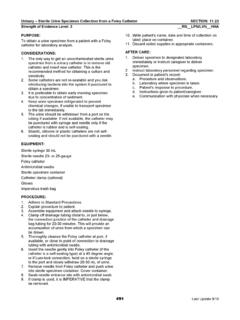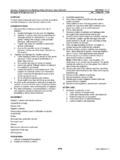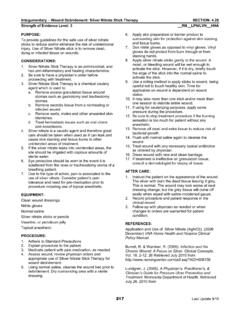Transcription of SECTION 4: INTEGUMENTARY: Removal of Jackson …
1 Integumentary Removal of Jackson pratt (JP) Drain SECTION : Strength of Evidence Level: 3 __RN__LPN/LVN__HHA PURPOSE: To safely remove a Jackson pratt (JP) drain in the homecare setting. CONSIDERATIONS: 1. Physician order is needed for the Removal of the JP drain. 2. The drain should not be removed if there is greater than 50 mL drainage in the last 24-hour period without report to the physician and specific orders to proceed with Removal . 3. If the drain cannot be easily removed, notify the physician. The drain should be left in position. EQUIPMENT: Gloves Suture Removal kit Sterile dressing/tape Double bag to dispose of drain PROCEDURE: 1. Adhere to Standard Precautions. 2. Explain procedure to patient. 3. Follow clean technique, assemble equipment. 4. Position the patient for comfort, easy access to the drain and privacy. 5. Remove any cover dressings and discard in double plastic bag.
2 4. Examine the drain site before removing sutures. 5. Remove sutures holding drain in place, if needed. Gently pull drain from wound. 6. Inspect the end of the drain for breakage. Ensure entire drain has been removed (the drain should have a clean edge and should not appear jagged). 7. Double bag and discard drain. 8. Place a sterile dry dressing over drain site and tape in place. AFTER CARE: 1. Document in patient's record: a. Procedure and observations. b. Patient's response to procedure. c. Appearance of the wound, amount, color and odor of drainage. d. Any instructions to patient about wound care, precautions, or signs or symptoms of complications. e. Any communication with the physician. 2. Instruct patient/caregiver in care of healing drain site including: a. Reporting redness, discharge or other signs of infection.
3 B. Changing the protective dressing. c. Showering or bathing, when permitted by physician. d. Signs and symptoms of complications. 205 Last Update 9/10206 Last Update 9/10











